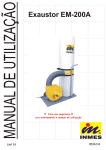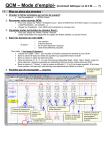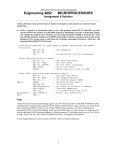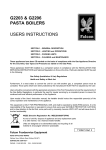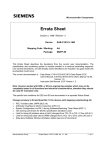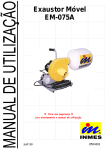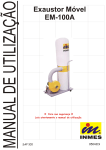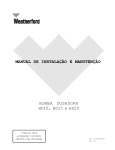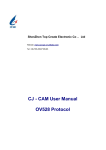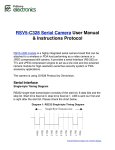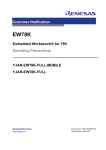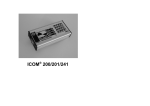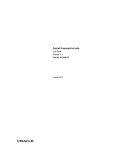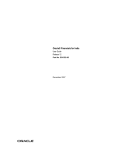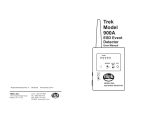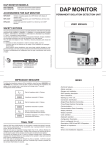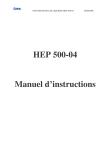Download Memorial University of Newfoundland
Transcript
Memorial University of Newfoundland Engineering 4862 MICROPROCESSORS Assignment 3 Solution 0. For each of the CF, PF, ZF, SF, and OF flags, briefly describe the meaning when it is set. Give conditional jump instructions that can be used to test each one. Flag CF PF ZF SF OF Description (when set) High-order bit carry or borrow Low-order 8 bits or result contain even number of 1-bits Result is zero Result is positive (if a signed number) Signed result cannot be expressed within the number of bits of destination operand Conditional Jumps JC, JNC, JAE, JNB, JB, JNAE JP, JPE, JNP, JPO JE, JZ, JNE, JNZ JS, JNS JO, JNO Notes: a. The description for CF states a high-order bit carry because the bit examined depends on whether the operands are 8-bit or 16-bit. On the addition of two 8-bit numbers, CF is set if there is a carry out of bit 7 (where the bits are numbered from 0 to 7). For two 16-bit numbers, the examined bit is number 15. b. The microprocessor does not know if you are adding or subtracting two numbers that are signed or unsigned. Thus OF is set or cleared whether or not signed numbers are used. Since the range for an 8-bit signed number is from –128 to 127, if two 8-bit numbers are added to get a value greater than 127, or less than –128, you will have to write code to convert the result to a 16-bit signed number. 1. a. Determine the contents of register BX and the six conditional (status) flags after each of the following instructions executes. If a flag or register contents are unknown, indicate with a ‘?’. CLC MOV BL, 4DH SUB BL, 3EH XOR BH, BH MOV SI], BX CLC MOV BL, 4DH SUB BL, 3EH XOR BH, BH MOV [SI], BX BX ?? ??4D ??0F 000F 000F CF 0 0 0 0 0 PF ? ? 1 1 1 AF ? ? 1 ? ? ZF ? ? 0 1 1 SF ? ? 0 0 0 OF ? ? 0 0 0 Notes: - XOR automatically sets the CF and OF to 0 - It does not matter what values is in BH, as XORing will set the result to 0! 4DH = 0100 1101 - 3EH = 0011 1110 0000 1111 - AF is set to 1 because there is a borrow from high-order 4 bits to the low-order 4-bits (between bits 3 and 4). - CF is set to 0, because there is no borrow into the high-order bit (bit 7) 1 b. Read how to use debug in appendix A of the textbook. For each instruction in (a), use DEBUG (or some other program) to determine the equivalent machine code. The machine code is given in bold in the following capture from DEBUG. Note that entering numbers in DEBUG automatically defaults to hexadecimal. This can be seen in the first MOV instruction, as the ‘4D’ is automatically translated into 4D as machine code. 12A7:0100 F8 CLC 12A7:0101 B34D MOV BL,4D 12A7:0103 80EB3E SUB BL,3E 12A7:0106 30FF XOR BH,BH 12A7:0108 891C MOV [SI],BX The 8086/88 user manual also tells you how many bytes that the instruction will be turned into and what machine code for each instruction. 2. Assume that the PUSH instruction does not exist in the 8086/8088 instruction set. Write a sequence of instructions that function equivalently to PUSH DX. You may use any other valid instruction, but restore any registers you change that PUSH DX does not. First, read what the push instruction does (page 3-132): it decrements SP by two, and then moves the source to the memory location given my SS:SP. The problem is that there is no addressing mode that allows you to use SP directly. The effective addresses allow different combinations of BP, BX, SI, and DI. We’ll use BP, as the microprocessor automatically uses the SS as the segment. However, we must be careful to not lose the existing value in BP! Attempt 1 (not quite right): SUB SP, 2 XCHG BP, SP MOV [BP], DX XCHG BP, SP ; ; ; ; decrement stack pointer save BP, and use value in SP move data to memory at SS:[BP] restore BP and SP This is not bad, but unfortunately the SUB instruction modifies a number of flags, and PUSH does not modify any flags. A correct method is to use an instruction we did not look at in class: LEA (load effective address). Read page 3-114 of the Intel User’s Manual for details. Essentially, you give the source as a valid memory reference, but the offset (not the value) is placed into the destination. It affects no flags, and uses no push instructions of any kind. Attempt 2: XCHG LEA MOV XCHG BP, SP BP, [BP] – 2 [BP], DX BP, SP ; ; ; ; save BP, get SP set BP to new memory location move data to memory restore BP and SP Other solutions are trickier to implement. If you use SUB, then you must figure out how to restore the flags to their original values. Note that PUSHF and POPF are available to your use. Attempt 3: PUSHF PUSHF ADD SP, 2 XCHG BP, SP MOV [BP], DX XCHG BP, SP SUB SP, 2 POPF ; ; ; ; ; ; ; ; 2 save flags at (original SP)-2 save flags again at (orig SP)-4 change SP to (original SP) - 2 swap SP and BP save DX restore SP and BP change SP to (original SP)-4 restore flags, SP = (orig SP)-2 This final attempt is the simplest of all (so far): Use PUSHF to update SP, but then overwrite the flags with DX – because none of the flags will actually be changed! Attempt 4: PUSHF XCHG BP, SP MOV [BP], DX XCHG BP, SP 3. ; ; ; ; save flags on stack swap SP and BP (SP has been updated) save DX to SS:BP restore SP and BP Write a subroutine to replace the multiplication instruction MUL CX. You may use any valid 8086/8088 instructions other than MUL, but take care to properly handle the flags and restore any registers that you use to store temporary values. Start your subroutine with the label mul_cx, and end with the RET instruction. MUL CX Notes on implementation: - Source is a word (CX), so result will be placed in DX (high word) and AX (low word) - CF and OF are either set (if DX is non-zero) or cleared (DX is zero) - AF, PF, SF, and ZF are undefined, but we’ll set them to zero - We’ll take care not to affect the other 3 flags (TF, IF, and DF) - The following algorithm is a simple, repetitive addition PUSH BX PUSH CX PUSHF ; save registers and flags MOV DX, 0 MOV BX, AX MOV AX, 0 ; clear DX & AX, used to store product ; use BX to count the number of additions JCXZ Done ; If multiplier is zero, so is the product Do_again: ADD AX, CX JNC Skip_hi INC DX ; Carry-out from AX, so increment DX Skip_hi: DEC BX JNZ Do_again ; continue BX times Done: POP CX ; Get flags ; Reset all flags except TF, IF, and DF AND CX, 0000011100000000b CMP DX, 0 ; is DX zero? JE Set_flags ; yes, so leave OF & CF as 0 ; DX is not zero, so OF = CF = 1 OR CX, 0000100000000001b Set_flags: PUSH CX POPF POP CX POP BX RET ; store flags ; restore correct flag values ; restore registers ; Done 3 4. Write a MUN-88-compatible program that reads the contents of the DIP switches, and then converts the 8-bit decimal value into two 8-bit ASCII values representing each hex digit. Store the lower digit in AL, and the upper digit in AH. This should be a full program, so include a title, segment definitions, etc., as well as comments. Example result: Suppose that after reading the input port for the DIP switches, AL is 9FH. Your program should place 39H (ASCII for ‘9’) into AH, and 46H (ASCII for ‘F’) into AL. DIPS equ 30h TITLE myseg DIP Converter SEGMENT ASSUME cs:myseg, ds:myseg, es:myseg Main: mov ax, cs mov ds, ax mov es, ax in al, DIPS mov ah, al and al, 0Fh call Convert ; ; ; ; read switch values copy values mask out upper 4 bits subroutine to convert AL to ASCII xchg ah, al mov cl, 4 shr al, cl call Convert xchg ah, al ; Swap AH and AL (for Convert) int 6 ; Finished ; Shift AL to right by 4 ; Convert AL to ASCII ; Swap AH and AL back ; **************************************************************** ; Convert – converts AL to ASCII, and stores resulting byte in AL ; **************************************************************** Convert: cmp al, 9 ja Letter add al, 30h jmp Done Letter: add al, 37h Done: ret myseg ENDS END ; Is AL above 9? ; Yes, so AL is a letter ; ASCII 30h to 39h are numeric ; ASCII 37h+Ah = 41h ; and ASCII 41h to 46h are ‘A’ to ‘F’ Main 4 5. Write a program that subtracts two multi-digit ASCII numbers (Data1 – Data2). The result should be saved back to Result in ASCII. The Data Segment is defined as following: DTSEG SEGMENT Data1 DB ‘3546882164’ Data2 DB ‘2345611245’ Result DB 10 DUP (?) DTSEG ENDS The approach I used is: first convert the ASCII numbers to packed BCD numbers (also stored in memory), then perform multi-byte packed BCD number subtraction (result also stored in memory), finally convert result to ASCII and save them to the location RESULT as required. All these functions are placed in subroutines. TITLE PAGE STSEG Subtracting ASCII Numbers 60, 132 SEGMENT DB 64 DUP(?) STSEG ENDS ;----------------DTSEG SEGMENT DATA1 DB ‘3546882164’ DATA2 DB ‘2345611245’ RESULT DB 10 DUP (?),”$” DATA1_BCD DB 5 DUP(?) DATA2_BCD DB 5 DUP(?) RESULT_BCD DB 5 DUP(?) DTSEG ENDS ;----------------CDSEG SEGMENT MAIN PROC FAR ASSUME CS:CDSEG, DS:DTSEG, SS:STSEG MOV AX, DTSEG MOV DS, AX MOV BX, OFFSET DATA1 MOV DI, OFFSET DATA1_BCD MOV CX, 10 CALL CONVERT_BCD MOV BX, OFFSET DATA2 MOV DI, OFFSET DATA2_BCD MOV CX, 10 CALL CONVERT_BCD CALL SUBTRACTION MOV SI, OFFSET RESULT_BCD MOV DI, OFFSET RESULT MOV CX, 5 CALL CONVERT_ASC MOV AH, 4CH INT 21H MAIN ENDP ;------------------- 5 ; SUBROUTINE CONVERT ASCII NUMBERS TO BCD NUMBERS CONVERT_BCD PROC NEAR REP0: MOV AX, [BX] XCHG AH, AL AND AX, 0F0FH PUSH CX MOV CL, 4 SHL AH, CL OR AL, AH MOV [DI], AL ADD BX, 2 INC DI POP CX LOOP REP0 RET CONVERT_BCD ENDP ;-------------------; SUBROUTINE PERFORM PACKED BCD NUMBER SUBTRACTION SUBTRACTION PROC NEAR MOV BX, OFFSET DATA1_BCD MOV DI, OFFSET DATA2_BCD MOV SI, OFFSET RESULT_BCD MOV CX, 5 CLC REP1: MOV AL, [BX]+4 SBB AL, [DI]+4 DAS MOV [SI]+4, AL DEC BX DEC DI DEC SI LOOP REP1 RET SUBTRACTION ENDP ;-------------------; SUBROUTINE CONVERT BCD NUMBERS TO ASCII NUMBERS CONVERT_ASC PROC NEAR REP3: MOV AL, [SI] MOV AH, AL AND AX, 0F00FH PUSH CX MOV CL, 4 SHR AH, CL OR AX, 3030H XCHG AH, AL MOV [DI], AX INC SI ADD DI, 2 POP CX LOOP REP3 RET CONVERT_ASC ENDP ;-------------------CDSEG ENDS END MAIN 6 6. Write a program that converts an ASCII string saved by Old_String to its uppercase in ASCII and save back to the New_String. Leave the space and period unchanged. The Data Segment is defined as following: DTSEG SEGMENT Old_String DB ‘This is THE String to be converted.’ New_String DB 35 DUP (?) DTSEG ENDS TITLE PAGE STSEG COVERT LOWER CASE TO UPPER CASE 60, 132 SEGMENT DB 64 DUP(?) STSEG ENDS ;----------------DTSEG SEGMENT Old_String DB “This is THE String to be converted.” New_String DB 35 DUP (?), “$” DTSEG ENDS ;----------------CDSEG SEGMENT MAIN PROC FAR ASSUME CS:CDSEG, DS:DTSEG, SS:STSEG MOV AX, DTSEG MOV DS, AX REP0: OVER: MOV SI, OFFSET Old_String MOV BX, OFFSET New_String MOV CX, 35 MOV AL, [SI] CMP AL, 61H ;IF LESS THAN ‘a’, THEN EXIT JB OVER CMP AL, 7AH ;IF GREATER THAN ‘z’, THEN EXIT JA OVER AND AL, 11011111B ; MASK d5 TO CONVERT TO UPPER CASE MOV [BX], AL INC SI INC BX LOOP REP0 MOV AH, 4CH INT 21H MAIN ENDP ;-------------------CDSEG ENDS END MAIN 7







